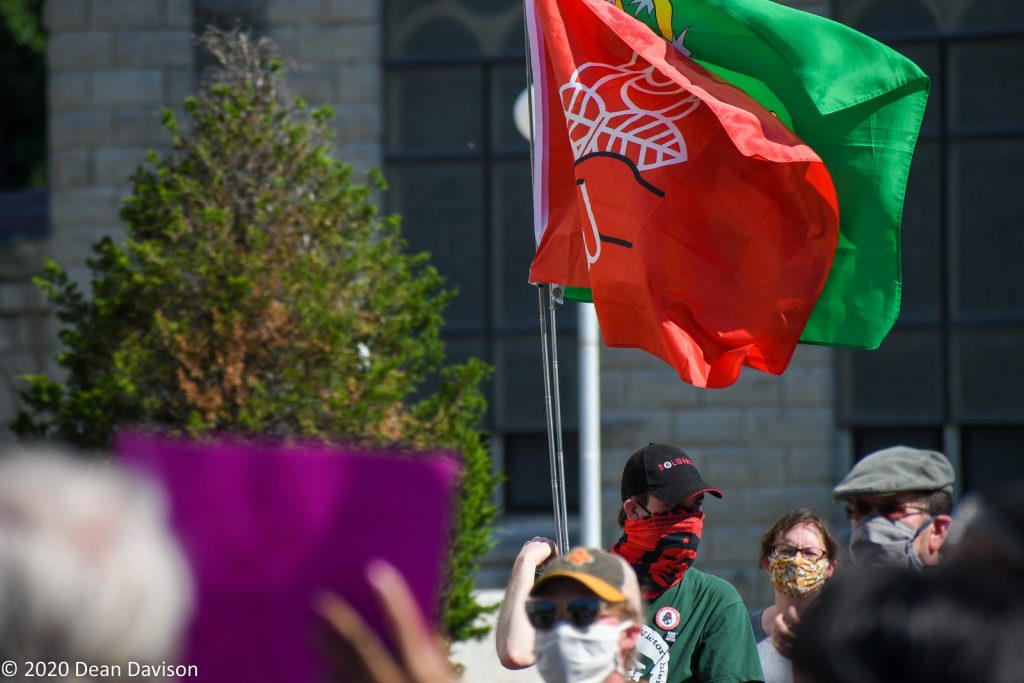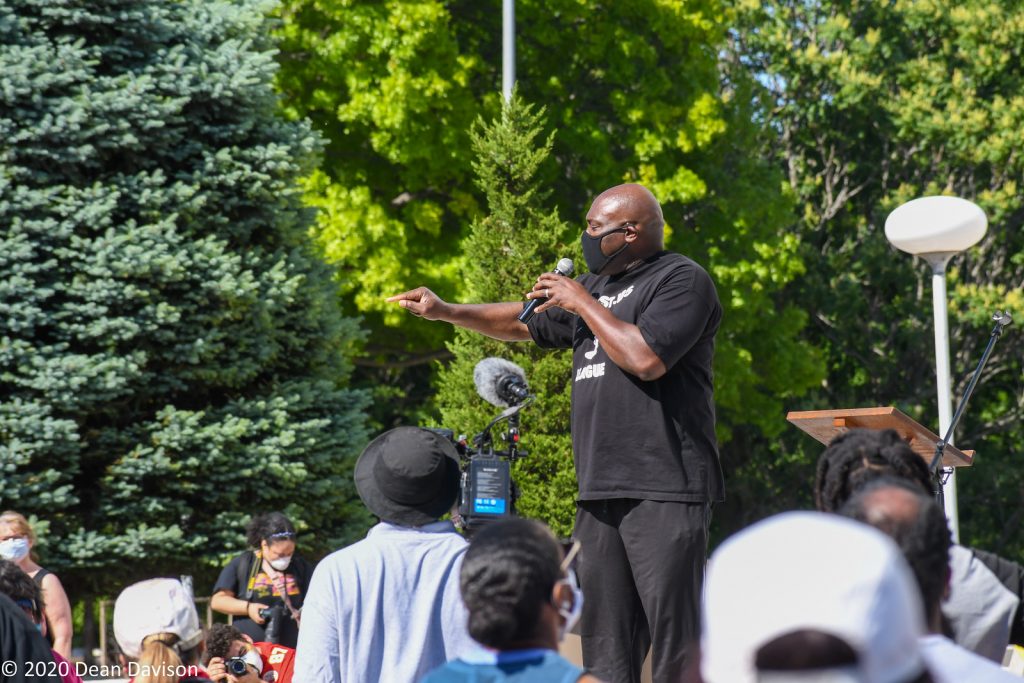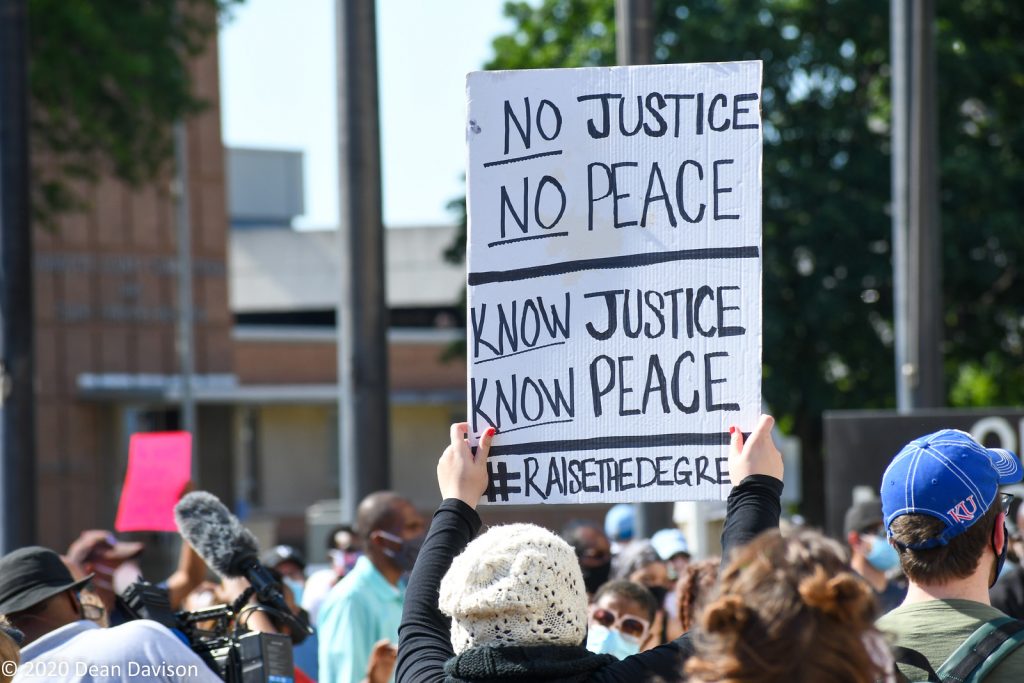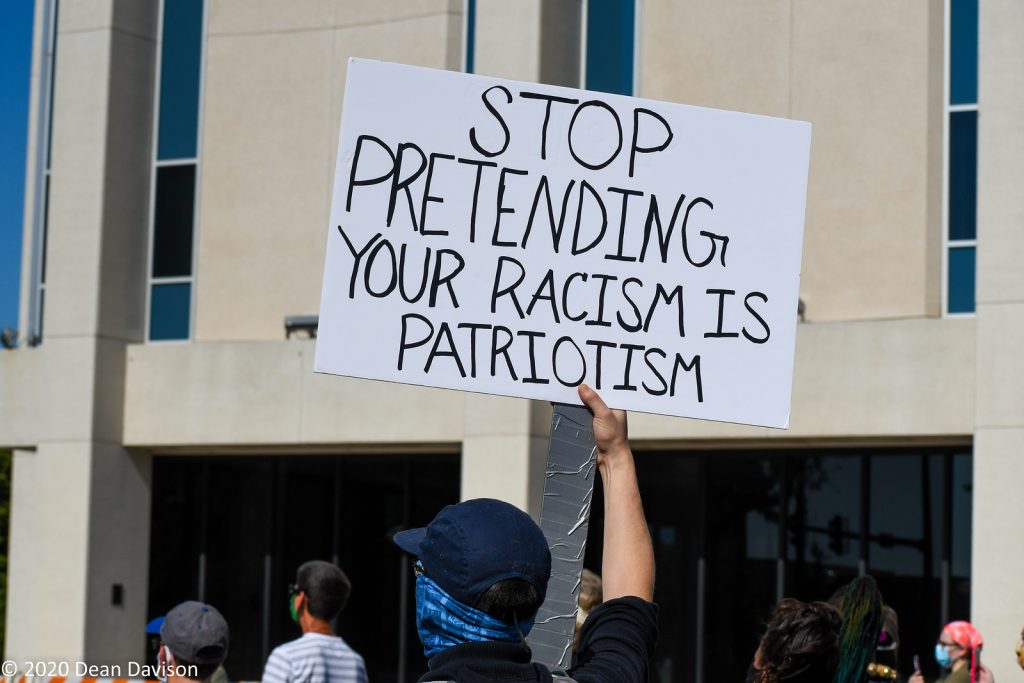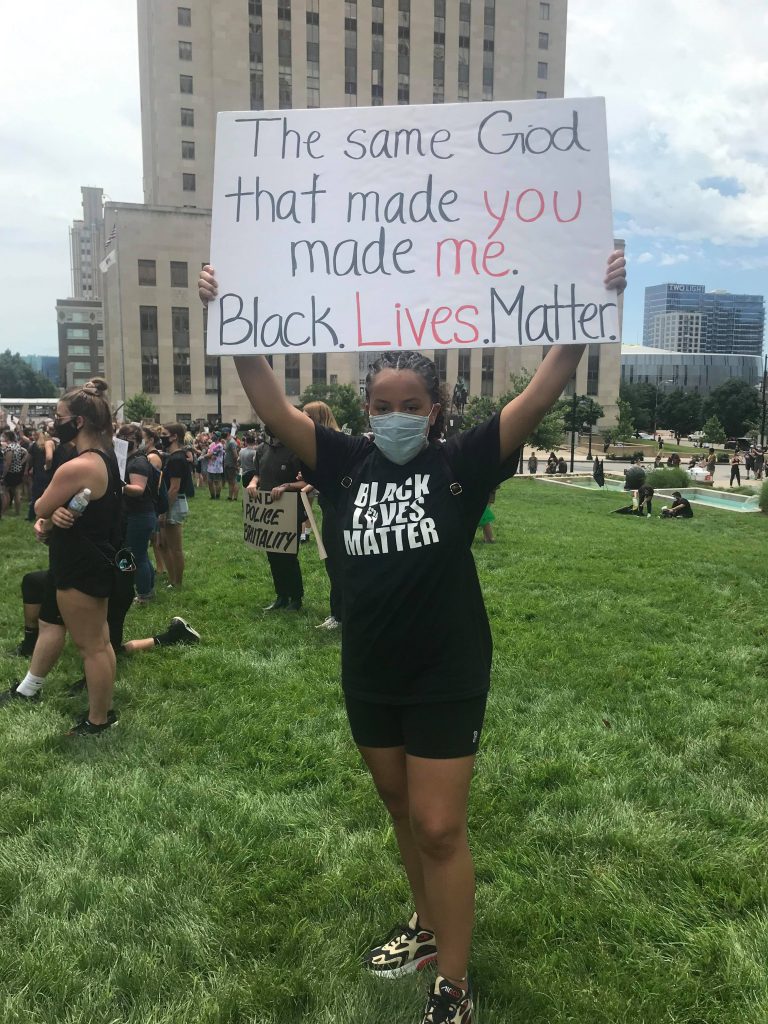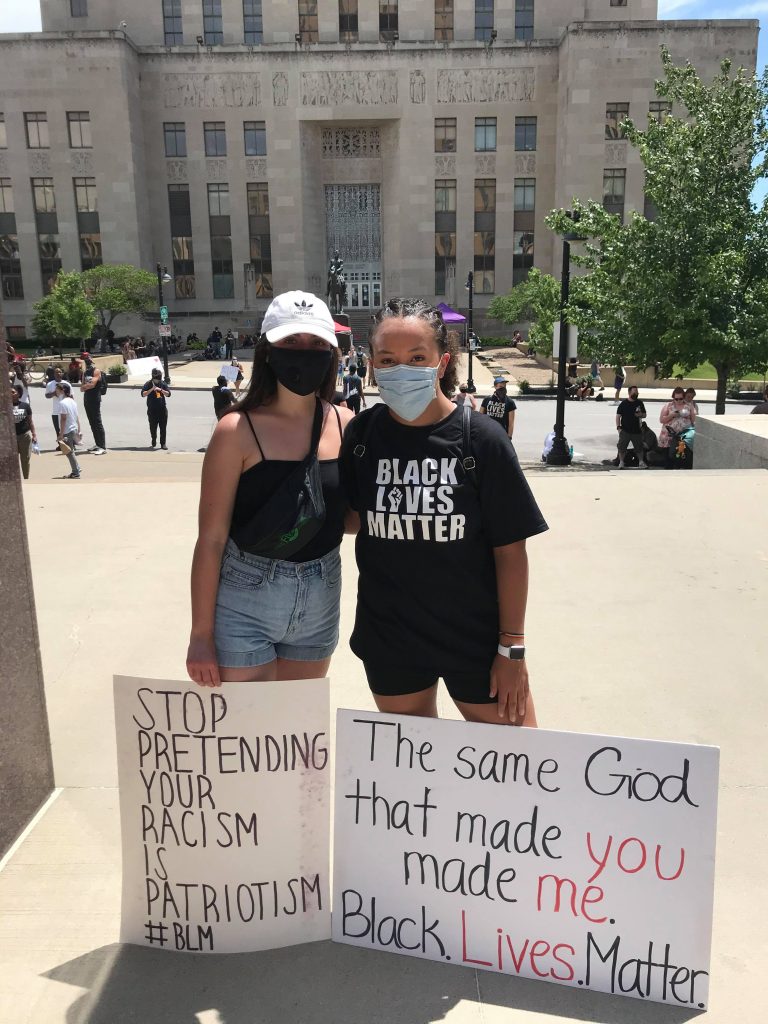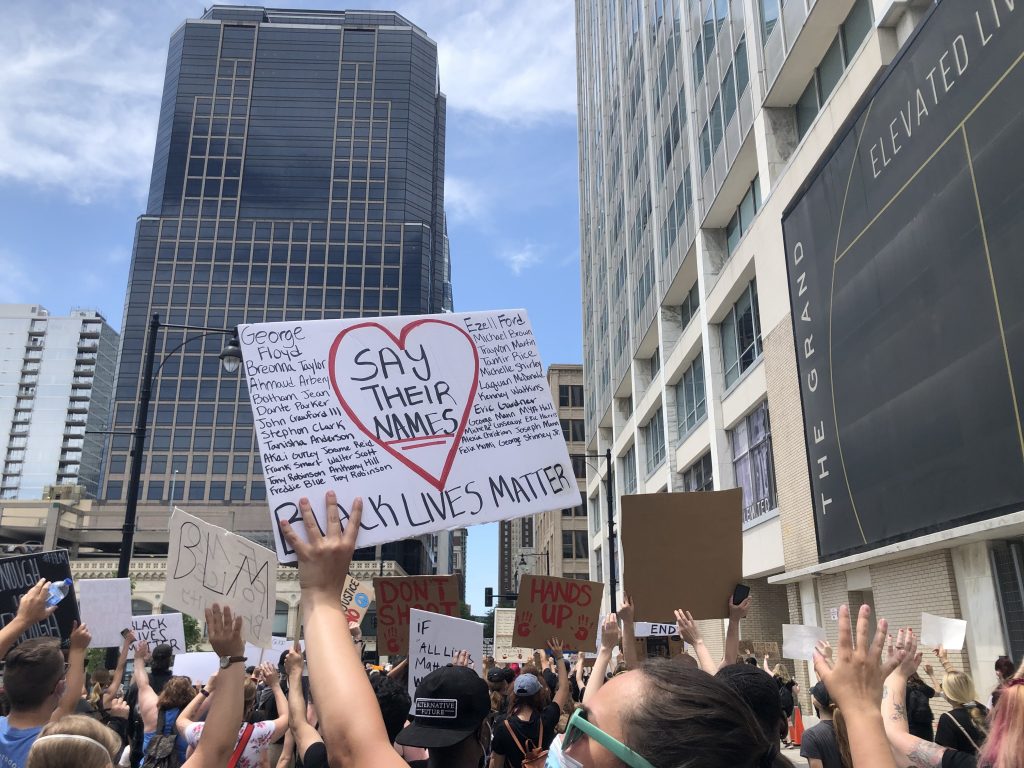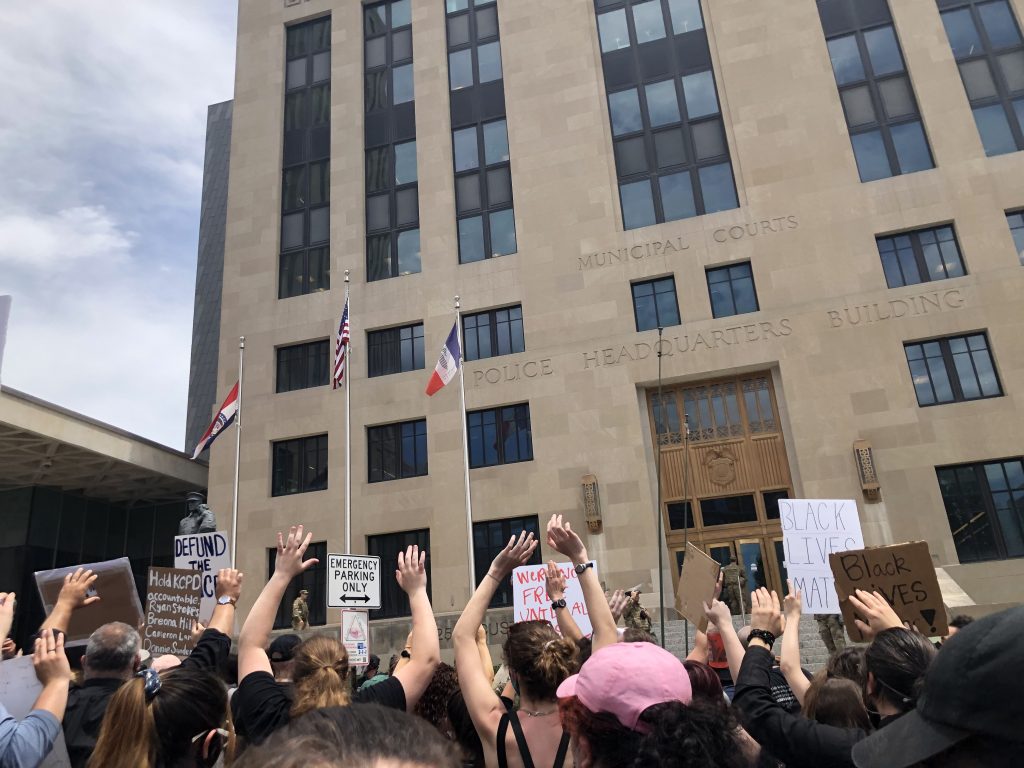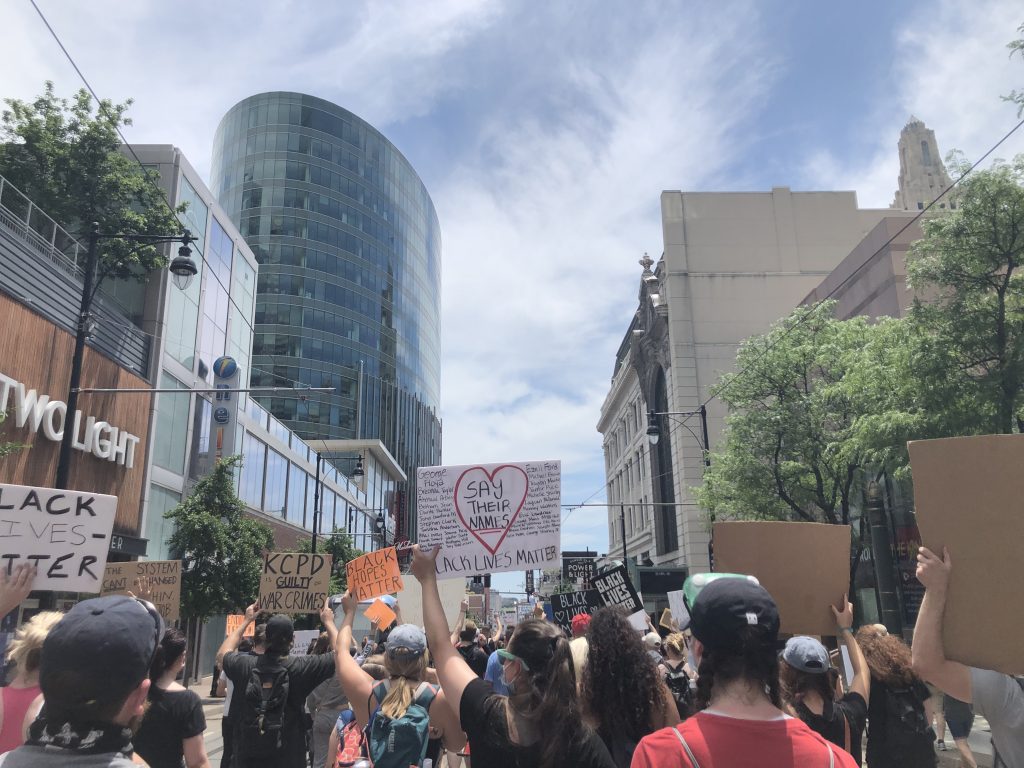Following the murder of George Floyd by Minneapolis police officers, several members of the Jewell community have been involved in Black Lives Matter activism, as well as standing against racism and police brutality. The following article features multimedia content and interviews with a few Jewell alumni and students who have attended recent protests against police brutality in the Kansas City area.
Elise Villarreal, senior English and theater major, attended Kansas City protests at the Country Club Plaza the weekend of May 30. She filmed a video depicting police arresting an unarmed protester and pepper-spraying members of the protest around the arrested man. This video has since gone viral and gotten over 8.4 million views. Villarreal posted other videos of the protest in the same Twitter thread that also depicted police aggression.
These videos can be viewed below.
CONTENT WARNING: physical assault, strong language
Villarreal was also injured in the protest. After being hit by a police baton from an officer arresting another protester, Villareal’s hand was broken in two places. In an interview with KSHB, she remarked that while she might want an apology from the Kansas City Police Department (KCPD), she ultimately just wants to see an end to police brutality.
Villarreal’s videos from the Plaza protest have been shared by multiple major news media organizations – including local media, like The Kansas City Star and KSHB, national media, like BuzzFeed News and Last Week Tonight, and international media, like the Daily Mail.
Talia Zook, ‘19, went to the protest in the afternoon of Sunday, May 31 with friends she had met through her job at City Year. Zook estimated that hundreds of protesters were in attendance. Several brought first aid supplies, water, snacks and poster board for others at the protest.
Though Zook was present at the protest well before curfew, she noted that the KCPD were already brandishing weapons, holding tear gas in hand, stockpiling zip-tie handcuffs and stationing snipers in towers around the Plaza.
Furthermore, she recounted the officers’ stoic presence as protesters implored them to demonstrate that their messages were being heard.
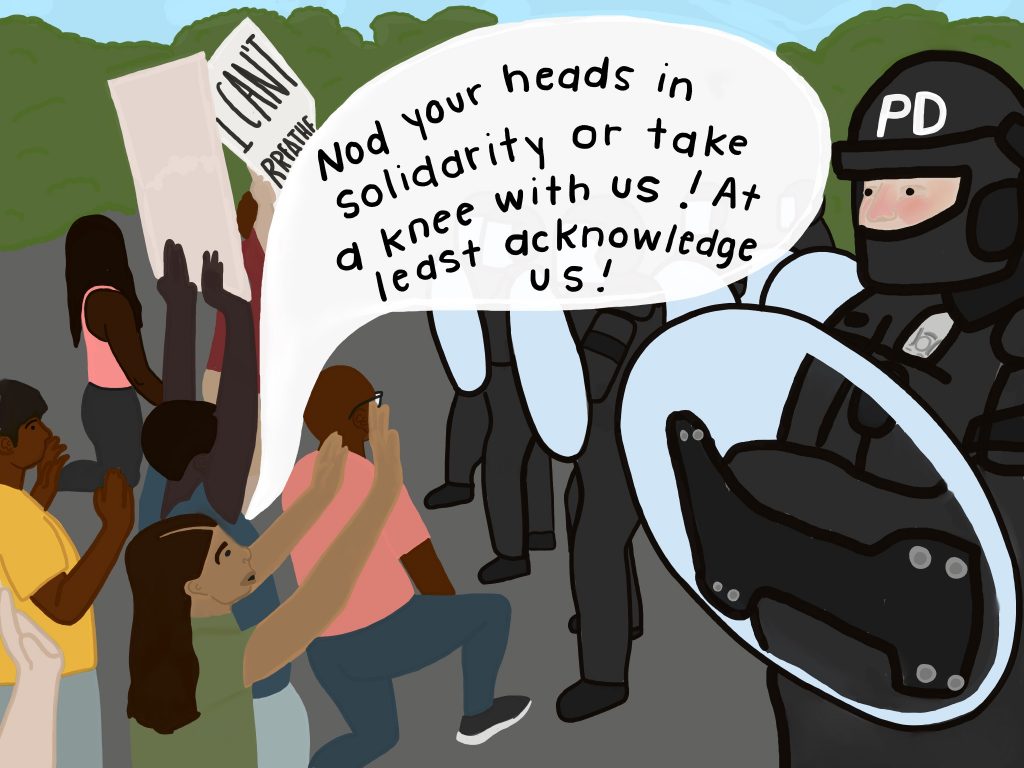
“The police presence was emotionless, and therefore cold. We threw out multiple opportunities for them to show they were there to acknowledge us, not to just enforce rules for us. ‘Nod your head in solidarity if black lives matter!’ ‘Take a knee with us!’ ‘At least acknowledge us!’ The cops were looking through everyone, aside from the handful of protestors who were either walking up and down the line leading chants, or engaging in 1:1 conversations with them. It seemed as though they would only listen to what you had to say if you walked up and stood in front of their face. Something a lot of us were not willing to risk, but we fortunately were among people who were,” Zook said.
Zook also attended the counter-protest to the KCPD’s unity march, which occurred Wednesday, June 3 at the Plaza.
This time, because curfew had been lifted, Zook arrived in the evening, at about 7:30 p.m. As midnight approached, two distinct, sizable groups of protesters either marched or protested in front of the cop line.
“Police presence was much more threatening this time, and I think it was just because we were there at night,” Zook said. “They were everywhere. Stacked, armed and poised for violence. Having been on the line that was in front of cops for some time before we left, all I saw was intimidation.”
Zook described what was effectively a standoff between police and protesters, with police demanding that protesters stay out of the street and away from the cop line. Police placed caution tape across the whole intersection and blocked off surrounding streets with their cars. Though protesters asked for the police to explain why they could not enter the streets, police did not respond.
“They also repeatedly asked protestors to keep their distance from the cops and back up. Mind you, there was a solid five feet between our line and theirs, with the exception of chant-leaders and individuals who wanted to share their stories with the officers who would listen. I heard the story of a man who’s best friend was sentenced to 12 years in prison for raping a white girl, even though there was no evidence of assault. She had one bruise on her leg, and that’s all they needed to convict his best friend to 12 years. It was really sad to hear, but it was also intriguing to see the way the cops reacted to his story because I felt it was very telling. There was sympathy in their response, but it almost seemed forced. It was like they recognized the tragedy, but still couldn’t believe any of their coworkers would have done that,” Zook said.
Zook’s last interaction on this night was with a police officer who was stationed with a colleague outside of a Main Street QuikTrip. As Zook’s friend walked inside to get a drink, she repeatedly said to them, “silence is consent to murder.” After she went inside, the officer said, “Yeah, we’re not doing that here.”
Zook, who was sitting in her car with the windows down observing this, recounted the conversation she had with the officer after her friend walked inside:
Zook: “We aren’t doing what here, sir?”
Cop: “Protesting. This is private property.”
Zook: “Who is protesting?”
Cop: silent
Zook: “Who is protesting?”
Cop: silent
Zook: “Who, is, protesting?”
Cop: “You heard me.”
Zook: “Alright, well I’m gonna go ahead and say whatever the f*ck I want to on this private property then. Get your public job off of this property since it’s so private.”
Cop: “Alright, well I have spray.”
Zook: “Ohhhhhhh, you’re mad huh? I just made you mad, didn’t I?”
Zook began joking with nearby protesters who had been observing about how quickly the officer became upset.
“[I]t was honestly very comical to me how he was upset enough by my words to threaten me. He was completely proving the point of the whole movement,” Zook said. “I continued to laugh and joke with the people in the car next to me as my friend came back outside, and then we saw the cop go inside and grab his pepper spray can from behind the counter. He was no longer able to look at us, but he came back outside with it in hand, shaking it as if he was preparing to use it. I decided to leave since we had everything we needed from the store, to which we received a very sarcastic, high school-like ‘GOODBYYYEEEEE!’ from the cops. I made sure to let cops know up the road that their coworker was at the QT intimidating protestors with spray. I don’t believe it was received, but I do know they heard me.”
Brendan Davison, ‘20, attended both the Saturday, May 30 protest at the Plaza and the Sunday, May 31 protest at the Kansas City, Kan., Municipal Court House.
Davison described the varying forms of support shown by protesters at the Plaza. Posters said anything from “Black Lives Matter” and “Justice for George Floyd” to listing the names of various black victims of police violence – even on a local level. Protesters chanted mantras with similar themes, including “Black lives matter,” “No justice, no peace” and “Say his name.”
Davison noted that, in addition to being much more well-attended and having a larger police presence, the protest at the Plaza was characterized by more tension and confrontation than the protest he attended at the Municipal Court House in Kansas. The latter protest focused on more local issues of injustice and brought in community leaders from political, activist and religious circles to make public addresses to attendees.
Discussing the police presence at the Plaza protest, Davison said that police often resorted to aggressive measures when protesters stepped off the west-facing curb by the JC Nichols Memorial Fountain into the closed-off JC Nichols Parkway. Officers often used pepper spray to stun those who did so before making arrests. Davison recalled witnessing one of the individuals who had stepped off the curb backed into a car, thrown on the ground and arrested by advancing police officers who were attempting to push protesters back out of the street.
“Because of their aggressive attitude towards the protests, I lay the blame for the violence, property destruction and general chaos that occurred on Saturday evening, after I left, on the KCPD, as the violence committed by some protesters was an escalating response to the aggression by the police. The police made no attempts at de-escalation, and instead resorted to physical force and intimidation from the outset. It also comes as no surprise that the ‘riots’ only began after the police deployed tear gas at 8 p.m., given the use of tear gas is often associated with not suppressing riots, but making riots more violent. For these reasons, I would classify this weekend’s events not as a violent protest, but as a police riot,” Davison said.
As a long-time member of the Democratic Socialists of America (DSA), Davison has opposed racism, police brutality and white supremacy and supported movements like Black Lives Matter for years. His local chapter of DSA has a prison abolition working group that has enabled Davison to be engaged in matters promoting racial equality and criminal justice reform. Some of their initiatives include compiling reports on the conditions of the Jackson County jail and advocating the abolition of cash bail in Kansas City. One of their partners is Reale Justice Network, which has set up a cash bail fund for local protesters who were arrested by police.
“One thing I did seek to draw attention to this weekend is promoting Irish American solidarity with the black community. As an Irish-American myself, I am gravely disappointed with many in the Irish-American community, who uphold and defend the system of white supremacy. As someone who identifies heavily with the Irish Republican tradition, I struggle to see how people so proud of their Irish heritage and Irish resistance to English imperialism and rule, cannot see the parallels between the treatment of the Irish by the English and the treatment of Black Americans by the police,” Davison said.
Shae Crane, senior elementary education major, attended the June 5 protest at Kansas City’s City Hall. Crane remarked that this protest was quite peaceful and that she did not witness any instances of police aggression.
“This protest was very peaceful compared to the protest[s] I have seen on the news,” Crane said. “We [stood] in front of City Hall and listened to various speakers then once the speakers were over we moved in front of the police headquarters. That’s when police in riot gear and military officers started to funnel out of the police headquarters building and form a wall between the protestors and the building. A few chants I remember were ‘Why are you in riot gear? I don’t see a riot here.’ ‘Hands up, Don’t shoot.’ ‘Say their names, ‘Breonna Taylor’ ‘George Floyd.’”
To Crane’s estimation, this protest was well-attended, with the City Hall courtyard effectively filled with protesters. Once the march began, passersby contributed by honking, if in cars, or stopping to join in chants.
In addition to attending this protest, Crane has shown her support for the cause in several other ways.
“I have been signing various petitions, sharing informational articles and attending protests. I also posted my story as a biracial woman in America and some of the situations and experiences I have been through,” Crane said.
Jamie Briscoe, senior chemistry major, attended the Saturday, May 30 Kansas City Plaza protest. Describing the tone of the protest, he shared that an overarching ambivalence of emotions – namely, unease, fear and courage – filled the atmosphere.
“You get to see all sides of humanity during something like this; you have people standing in front of the protest who are face to face with police in all their riot gear, something that took more courage than I have ever needed. Everyone is in an extremely emotionally raw state due to the extreme adrenaline there. There are also people who are responsible for seeking out those who’ve been injured and helping them get proper medical care, be it from tear gas, rubber bullets, or the crowd trampling them as they retreat from the police. There are also less positive things you will see. I watched cowards stand 50 feet away, hiding behind other people as they threw rocks or water bottles in an attempt to incite a police response. This was almost always met with rounds of protesters trying desperately to stop them, and keep the police from unleashing even more tear gas,” Briscoe said.
In terms of the police presence at the Saturday protest, Briscoe noted that protesters far outnumbered police officers, but each officer was fully equipped with riot gear, including mace, sandbag bullets, shields, tear gas and flashbangs.
Briscoe was tear-gassed by police twice during the protest. The first time, police deployed tear gas in response to a car that had been set on fire – which Briscoe had not been a part of – in an effort to prevent rioters from causing more damage.
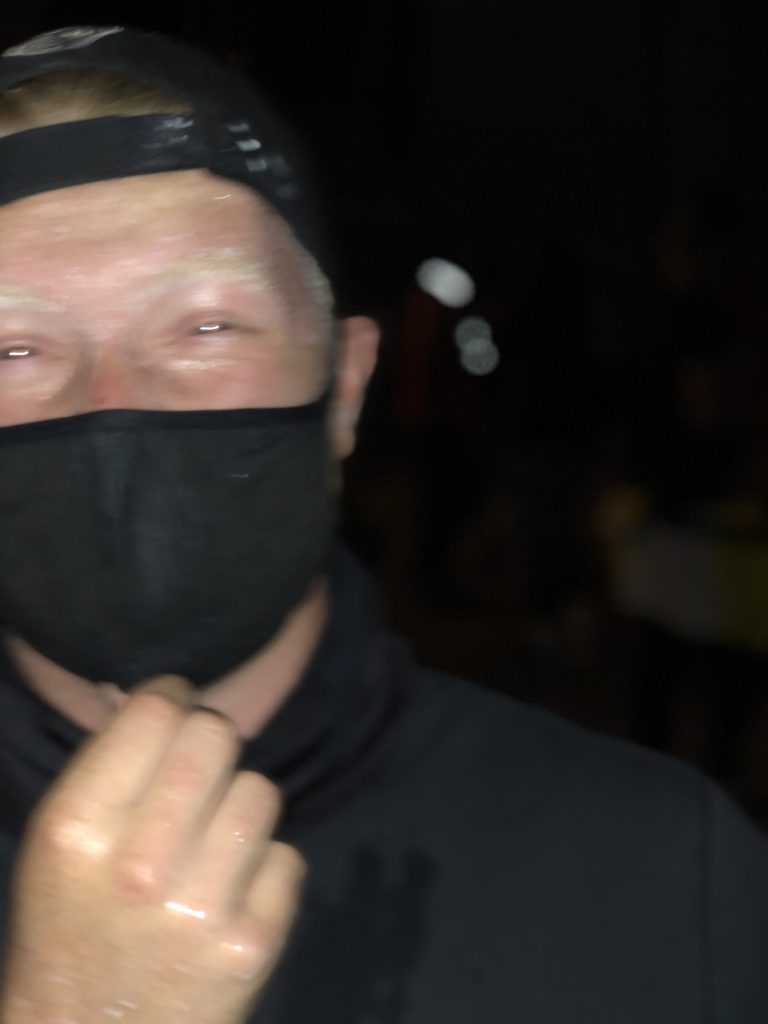
“The second time I was gassed, however, was a result of what I think was police handling the situation poorly. Me and a group of several people had kneeled to chant about 10 feet from one line of cops in gear, when cops behind us shot tear gas. This was especially painful because it meant we could not get rid of the canister before it had released all of its harmful chemicals, and so all of us kneeling had to run blindly to safety,” Briscoe said. “My friend who I had gone with was so disoriented by the pain and blindness that he accidentally ran towards the cops in fear; they responded by shoving him to the ground and yelling for him to get back while he yelled and wretched.”
This was Briscoe’s first time attending a protest, though he has shown support in other forms to related causes in the past. In a final statement, he emphasized the importance of actively engaging in efforts to resist injustice and oppression.
“My final point is only to say this: White silence is violence. If you are disinterested in supporting minority groups, you are allowing oppression to continue and benefit you. Everybody go protest and be a part of the positive change, the experience is not only vital to help these movements succeed, the personal growth you can feel is immense,” Briscoe said.
*Quotes have been reformatted to follow Monitor style guidelines.







